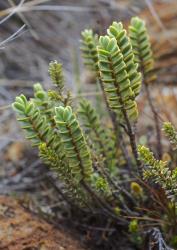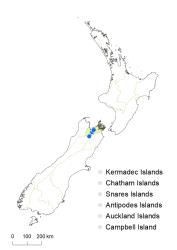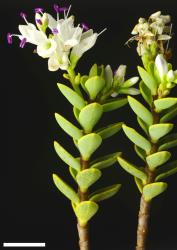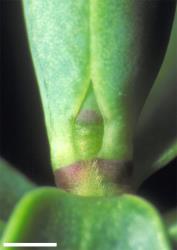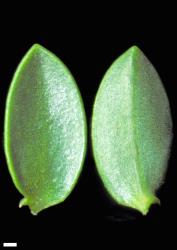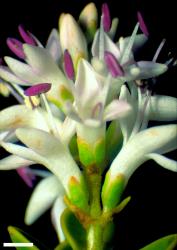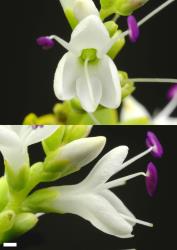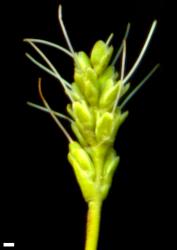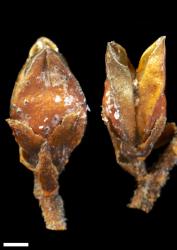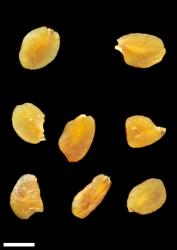- ≡ Veronica laevis var. carnosula Hook.f., Bot. Antarct. Voy. II. (Fl. Nov.-Zel.) Part I, 210 (1853)
- ≡ Veronica carnosula (Hook.f.) Hook.f., Handb. New Zealand Fl. 210 (1864) nom. illeg., non Veronica carnosula Lam. 1791
- ≡ Hebe carnosula (Hook.f.) Cockayne, Trans. New Zealand Inst. 60: 469 (1929)
Low shrub to 1 m tall. Stems erect, eglandular-puberulent, glabrous with age; hairs bifarious. Leaf bud distinct, its outer leaves fully grown, appressed at margins; sinus acute. Leaves opposite-decussate, sub-erect to spreading, lamina coriaceous, elliptic to obovate, 6.0–12.5 mm long, 4.5–9.0 mm wide, dull olive-green to sub-glaucous or glaucescent above, glaucescent or glaucous beneath; midrib evident; surfaces glabrous; margin glabrous, minutely papillate, entire; apex obtuse to sub-acute or weakly apiculate; base cuneate to truncate; petiole 1.0–1.5 mm long. Inflorescence a lateral spike or raceme, 12–30 mm long; flowers crowded, 6–22, female or bisexual on separate plants, ⚥ > ♀; bracts opposite-decussate, sometimes becoming alternate above, lanceolate to ovate, > pedicels; pedicels absent or erecto-patent, 0–1.5 mm long, eglandular-hairy all around. Calyx lobes 4–5 (5th small, posterior), obtuse to sub-acute, 1.5–2.8 mm long, sub-equal, mixed glandular- and eglandular-ciliate or -ciliolate. Corolla 5–9 mm diameter; tube white, 2.1–2.7 mm long, ≥ calyx, glabrous; lobes 4, white, erecto-patent to spreading, sub-equal, lanceolate to narrowly elliptic, 3–5 mm long, obtuse to rounded; nectar guides absent. Stamen filaments white, 2.5–5.2 mm long; anthers magenta. Style glabrous or sometimes eglandular-hairy, especially towards base, 5–6 mm long. Capsules latiseptate, sub-acute to obtuse, glabrous or rarely a few eglandular hairs at apex, 3.0–4.5 mm long, 2.6–3.0 mm at widest point. Seeds oblong to elliptic, flattened, smooth, brown, 1.3–1.7 mm long.
Veronica baylyi plants have a distinctive appearance, and may be distinguished from other glaucous hebes on a suite of minor characters. The plants generally have an erect habit (but sometimes can be straggly, depending on environment), glaucescent to olive-green leaves, narrow acute sinus, rounded calyx lobes, and mostly glabrous capsules. Those features distinguish it from V. pinguifolia, which can occur nearby and further south. Also, V. baylyi is strictly confined to ultramafic rocks, whereas V. pinguifolia occurs on a range of substrates, but mostly on greywacke and never on ultramafic rocks. V. pinguifolia leaf buds normally lack a sinus, but some plants in Marlborough and Nelson have a small sinus at the base of the bud, rather shorter and broader than the sinus of V. baylyi plants.
South Island: Sounds Nelson (Bryant Range: Dew Lakes, Mt Starveall, Dun Mountain; Red Hills Range).
Scrub and grassland on ultramafic rocks. Recorded elevations range from 762 to 1600 m.
Near the margins of the ultramafic belt, especially on the Red Hills Range, plants may be more variable, especially in leaf colour, and it seems possible that some hybridisation is occurring. Both V. brachysiphon and V. subfulvida grow nearby.
Flowers: November–January, sometimes extending to April; fruits: January–April.
The chromosome number of V. baylyi is not yet established, but preliminary counts (B. Murray, pers. comm.) and flow cytometry results (H.M. Meudt, pers. comm.) indicate it is close to 2n = 120.
Veronica baylyi is classified in V. subg. Pseudoveronica sect. Hebe and the informal group “Apertae” (small-leaved) (Albach & Meudt 2010; Bayly & Kellow 2006).
Veronica baylyi had been placed incertae sedis by Moore (in Allan 1961, as Hebe carnosula), and Cheeseman (1906, 1925, as V. carnosula) gave it a broader circumscription to include plants treated here as part of the range of V. pinguifolia.
The seed description above is based on a single collection. We need more collections of V. baylyi fruit and seed to establish the range of variation.



